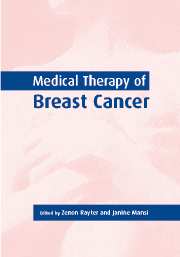Book contents
- Frontmatter
- Contents
- List of contributors
- 1 History of breast cancer therapy
- 2 Chemoprevention of breast cancer
- 3 Familial breast cancer
- 4 Hormone replacement therapy and breast cancer
- 5 Screening for breast cancer
- 6 The management of in situ breast cancer
- 7 Adjuvant systemic therapy
- 8 Adjuvant radiotherapy in the management of breast cancer
- 9 Predictors of response and resistance to medical therapy
- 10 Primary medical therapy in breast cancer
- 11 Medical therapy of advanced disease
- 12 Experimental approaches
- 13 The place of bisphosphonates in the management of breast cancer
- 14 Palliative care in breast cancer
- Index
2 - Chemoprevention of breast cancer
Published online by Cambridge University Press: 06 January 2010
- Frontmatter
- Contents
- List of contributors
- 1 History of breast cancer therapy
- 2 Chemoprevention of breast cancer
- 3 Familial breast cancer
- 4 Hormone replacement therapy and breast cancer
- 5 Screening for breast cancer
- 6 The management of in situ breast cancer
- 7 Adjuvant systemic therapy
- 8 Adjuvant radiotherapy in the management of breast cancer
- 9 Predictors of response and resistance to medical therapy
- 10 Primary medical therapy in breast cancer
- 11 Medical therapy of advanced disease
- 12 Experimental approaches
- 13 The place of bisphosphonates in the management of breast cancer
- 14 Palliative care in breast cancer
- Index
Summary
Introduction
At present we are in an era of controlled clinical trials evaluating chemoendocrine agents in the prevention of breast cancer. Although breast cancer deaths (in the UK and USA) have now started to decline (Peto et al., 2000), the commitment to this approach originated in the recognition that early diagnosis and improvements in treatment had not translated into an order of magnitude step-down in mortality figures. Research directed at primary prevention of breast cancer has become a priority, especially for those women who are at increased risk of developing the disease. This is further enhanced by the emerging detail of breast cancer genetics, heralded with the identification of BRCA1 and BRCA2, and the consequent ability to refine risk assessment, along with developments in the understanding of breast cancer biology, the oestrogen receptor (ER) and the availability of new selective oestrogen receptor modulators (SERMs).
In the early months of the year 2000 there was intense pressure on these prevention trials. Tamoxifen in the National Surgical Adjuvant Breast and Bowel Project (NSABP) P1 Breast Cancer Prevention Trial has been reported to reduce the incidence of invasive (and noninvasive) breast cancer when compared to placebo (Fisher et al., 1998), and as a consequence the Food and Drug Administration (FDA) have approved tamoxifen for breast cancer risk reduction in high-risk women. In contradistinction, the preliminary analyses of the Royal Marsden, London, UK and Italian tamoxifen randomized chemoprevention trials (Powles et al., 1998a; Veronesi et al., 1998) yielded null results.
- Type
- Chapter
- Information
- Medical Therapy of Breast Cancer , pp. 37 - 60Publisher: Cambridge University PressPrint publication year: 2003



